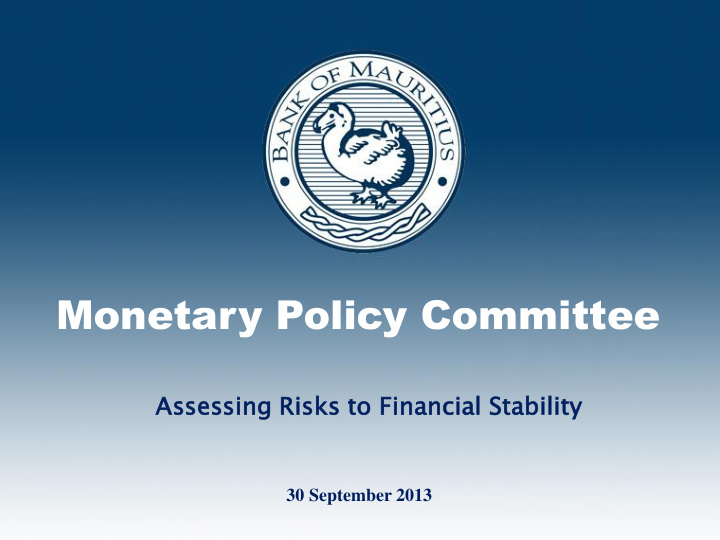



Monetary Policy Committee Assessi essing ng Ri Risks s to Financi ancial al Stab abil ility ity 30 September 2013 0
Inflation Forecasting at the Bank of Mauritius Econometric Models for Inflation Forecasting include: 1. ARMA Model 2. VaR Model • The BoM also continues to use and refine its GAPS model which provides forecasts for various variables such as growth and inflation. • The Bank also relies heavily on expert judgement when forecasting inflation in the medium term. • Judgement plays a key role when it comes to inflation forecasting vs. Over-reliance on models. 1
The Largest Private Groups in Mauritius have used lower interest rates to take on even more debt… Source: BOM Staff Estimates based on annual reports of the largest corporates. 2
… while free cash flows have been decreasing, leading to a deterioration in corporate balance sheets 3
The Debt Situation… • Working Capital Pressures on the Balance Sheet continue to eat away at Free Cash Flow and lead to a high reliance on short term debt to finance operations. These are structural problems. • Many large groups generate negative carry with return on capital lower than their cost of debt. Structural problem and management inefficiency. Free Cash Flow to Debt Ratios have worsened. • Demand expectations which led to heightened CAPEX have not materialised, ex: tourism. • Rental Yields in many Commercial Real Estate Projects remain below the cost of financing yielding to negative arbitrage and cash flow pressures. Oversupply in commercial real estate space kept pressure on rental yields. 4
Risks to Financial Stability posed by certain large groups remain a concern for the BoM Source: BOM Staff Estimates based on annual reports of the largest corporates. 5
Debt levels of distressed zone companies are not sustainable and require structural solutions 6
Sustained Deviations from Trend in Credit Growth to certain sectors point to signs of overheating Housing Credit Property Development Credit Hodrick-Prescott Filter (lambda=100000) Hodrick-Prescott Filter (lambda=100000) 50,000 25,000 Property Development 20,000 Housing Loans 40,000 Trend Trend 15,000 Gap Gap 30,000 10,000 5,000 20,000 2,000 0 2,000 10,000 1,000 1,000 0 0 -1,000 -2,000 -1,000 -3,000 -2,000 -4,000 2005 2006 2007 2008 2009 2010 2011 2012 2013 2005 2006 2007 2008 2009 2010 2011 2012 2013 Source: BOM Staff Estimates. 7
Exposure of Banks to the Construction Sector continues to grow despite rising NPLs from this sector Source: Bank of Mauritius. 8
With the investment capacity of the private sector constrained, Government must do more to avoid coordinated deleveraging Source: Statistics Mauritius. 9
Mauritius as a country is simply not competitive enough. Our over- reliance on consumption contributing to a high CAD not sustainable Source: BOM Staff Estimates. 10
What the Bank of Mauritius is doing beyond the MPC • Assessment of the exposure of banks to the debt of large groups with weak Balance Sheets in order to gauge concentration risk. Stress tests to provide gauge of cushion requirements on top of minimum Basel requirements. • Bank of Mauritius consulting with banks on the implementation of macro- prudential measures, especially in the real estate sector. Trying to limit speculation on properties in excess of Rs5M. • Bank is concerned by the speed of asset rotation from deposits to real estate as inflationary expectations remain above savings rate. Herd mentality and speculation a concern. • Negative real interest rates lead to mis-allocation of capital as seen in the high levels of indebtedness in the private sector with weak free cash flows. • Economy over-reliant on real estate/construction. Not sustainable with a need for further diversification. 11
Monetary Policy has its limits • Monetary Policy cannot resolve long term structural problems in the private sector. In fact, more debt has been taken as rates have been cut creating even more risk to financial stability. • Structural problems require structural solutions. More can be done with Government, banks and the BoM. Example: BoM has provided more than 40M EUR via banks to the tourism and export sectors for better asset liability matching and to lower the cost of debt of firms. Firms need to restructure their businesses and clenze balance sheets. • Endless interest rate and exchange rate subsidies discourages the private sector from focusing on efficiency. Need to look at other tools beyond the repo rate especially with fast falling savings rate as a % of GDP. Same old measures have not worked. • Government must sustain CAPEX investments and focus on structural reforms in order to sustain long term growth above 4%. • Over-reliance on real estate/construction be it locally or from foreign investments not sustainable drivers of growth. Call on more economic reforms that are structural in nature. 12
Thank you 13 13
Recommend
More recommend